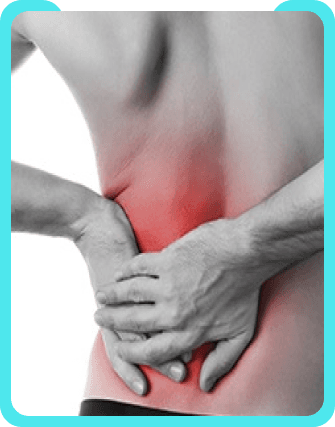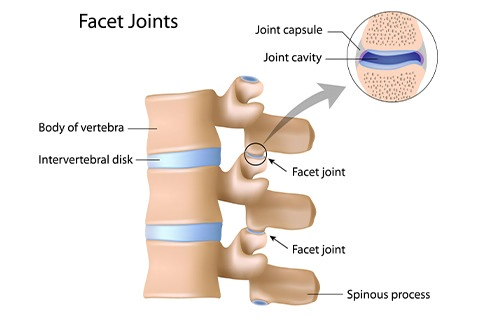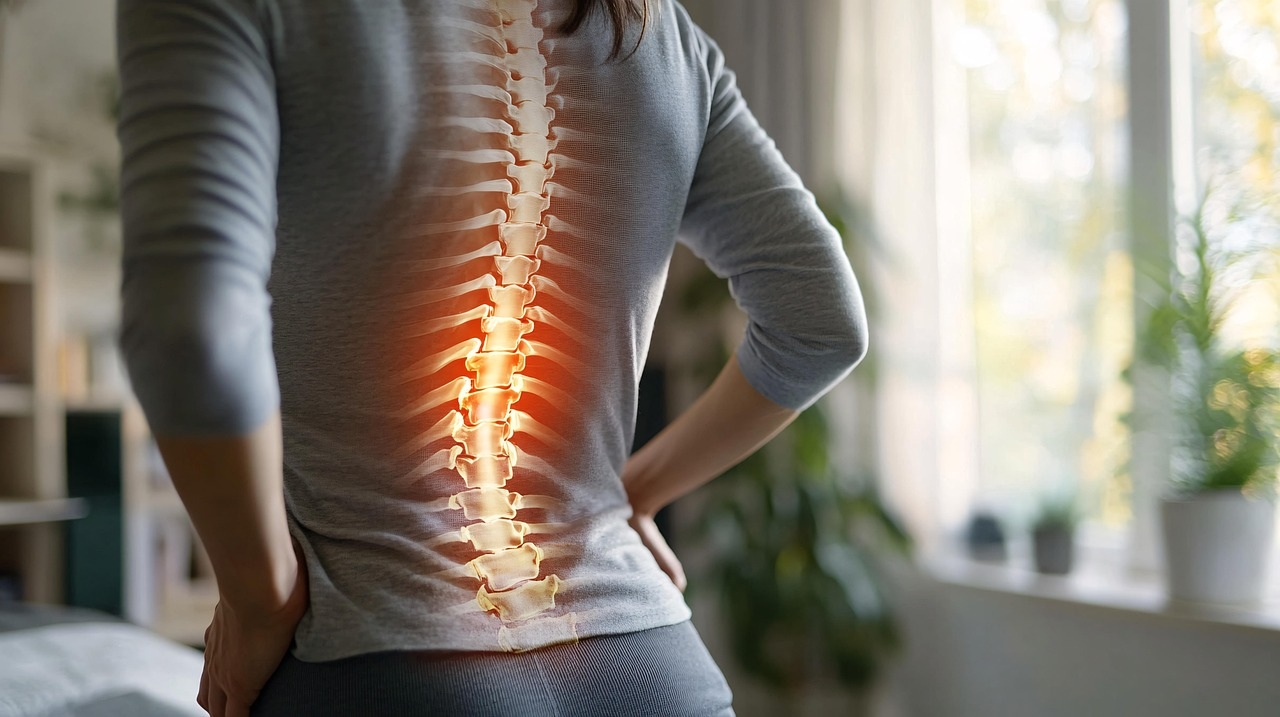
Facet Joint Syndrome
- Home
- Conditions
- Back & Spine Conditions
- Facet Joint Syndrome
Facet joint disorders are some of the most common of all the recurrent, disabling low back and neck problems, and can cause serious symptoms and disability for patients. However, facet joint problems rarely involve the spinal nerves. Facet joint syndrome is an arthritis-like condition of the spine that can be a significant source of back and neck pain. It is caused by degenerative changes to the joints between the spine bones. The cartilage inside the facet joint can break down and become inflamed, triggering pain signals in nearby nerve endings. Medication, physical therapy, joint injections, nerve blocks, and nerve ablations may be used to manage symptoms. Chronic symptoms may require surgery to fuse the joint.
Treatment for Facet Joint Syndrome
Anatomy
These are joints which help the vertebrae, which are the building blocks of the spine to articulate with each other. Each vertebra gives out a superior articulating process and an inferior articulating process which contribute to the joint above and below. These are true synovial joints which are lined by an articular cartilage, have synovial fluid to promote lubrication of the joint surface and are covered by a capsule.

Function
These joints facilitate movements of the spine like forward flexion and twisting as the articular surfaces glide over each other, but at the same time also contribute to the stability as the joints interlock strongly in certain planes preventing excess movement in that plane e.g.. extension
Nerve Innervation
Mixed spinal Nerve gives rise to the dorsal rami or the posterior primary division and the ventral rams or anterior primary division. Now the PPD gives rise to lateral and medial branches. These medial branches in turn give rise to ascending and descending branches. The ascending supplies the joint above and the descending branch supplies the joint below
Causes -
- Traumatic degeneration of the facet joints. The primary insult may be motor vehicle accident, fall from height, etc
- Age related degeneration of the joints or the mechanical degeneration of the joints. Anyone who lives long enough will definitely have some degenerative changes in the spine. But sometimes it becomes painful needing attention
- Occupational hazards – Labourers may face this because of years of carrying heavy weights on their head and shoulders
Symptoms-
Facet joint degeneration can be painless until an event triggers symptoms. There are several symptoms that indicate a person’s pain is coming from the facet joints. The pain is often a diffuse, dull ache in the low back directly over the spine that can spread to the buttocks. In the neck it can be felt in the shoulders and back of the skull.
Acute episodes of lumbar and cervical facet joint pain are typically intermittent, generally unpredictable, and occur a few times per month or per year.
Most patients will have a persisting point tenderness overlying the inflamed facet joints and some degree of loss in the spinal muscle flexibility (called guarding).
Typically, there will be more discomfort while leaning backward than while leaning forward.
Low back pain from the facet joints often radiates down into the buttocks and down the back of the upper leg. The pain is rarely present in the front of the leg, or rarely radiates below the knee or into the foot, as pain from a disc herniation often does.
Similarly, cervical facet joint problems may radiate pain locally or into the shoulders or upper back, and rarely radiate in the front or down an arm or into the fingers as a herniated disc might.
Diagnosis-
Imaging Modalities like X rays especially oblique views , CT and MRI can not only point towards the diagnosis of facet joint disease but it also helps in excluding other causes and other red flag signs of the spine
The most reliable test is an injection of local anaesthetic into the joint or into the nerves supplying the joint. If this does not relieve the pain it is unlikely that the pain is coming from the facet joints.
Treatment-
Conservative :- NSAIDs have been used to help during flareups of pain. Other supportive measures like rest, spine strengthening exercises, hydrotherapy and traction can be tried. Osteopathic and Chiropractic manipulations have also seen to help some people to a great extent
Interventional- When these measures do not provide adequate relief, interventional pain management comes into play. Mixture of LA and steroid have been injected around the nerves supplying the joint (well known as medial branch block) or directly into the joint itself. While blocking the nerves usually two- three levels are addressed at once owing to the peculiar nerve supply of these joints.These serve to be diagnostic as well as therapeutic. Blocking the nerves is preferred nowadays to injecting into the joint.
Regenerative Medicine – Some centres are using Prp and stem cells into the facet joint to prvent the progression of arthritis but the efficacy of these procedures has yet to be proven in large scale studies.
Patients in whom the pain comes back after successful injections can be considered for radiofrequency ablation or rhizotomy of the medial branches supplying the facet joint
Surgery-
Facetectomy and foraminotomy to increase the the dimension of the intervertebral foramen and achieve adequate decompression of the affected nerve root when required
Finally fusion surgery of two or more vertebrae is carried out to eliminate movement at the affected level hence eliminating the pain producing movement.
Prevention-
Eliminating the cause , for instance a manual labourer with early symptoms may need to have amended duties to prevent the progression Excercises to strengthen the spine and increase the mobility . People should be encouraged to take up some physical activity like yoga, pilates, aerobics or athletics whichever suits them.
Watch your weight.
Differential Diagnosis-
- Sacroiliac joint disease
- Disc Prolapse/Migration
- Ankylosing Spondylitis
- Piriformis syndrome
- Endometriosis
- Myofascial Pain
- Hip Pain
at Alleviate Pain Clinic
- Purpose: Diagnose and treat facet joint pain.
- Procedure: Injection of a local anesthetic near the medial branch nerves.
- Benefits: Immediate pain relief, confirmation of facet joint pain source.
- Purpose: Promote natural healing.
- Procedure: Injection of platelet-rich plasma (PRP) into the affected area.
- Benefits: Long-term pain relief, tissue regeneration, reduced inflammation.
- Purpose: Stimulate tissue repair and reduce pain.
- Procedure: Injection of a solution (often dextrose) into the affected area.
- Benefits: Strengthened connective tissue, long-term pain relief, reduced inflammation.
- Purpose: Provide long-term pain relief by disrupting pain signals.
- Procedure: Using heat to ablate the medial branch nerves.
- Benefits: Long-lasting pain relief, improved function, minimally invasive.
Combined Approach
- Conservative Treatments: Physiotherapy to improve mobility and strength.
- When to Consider Invasive Treatments: Persistent pain and functional impairment despite conservative management.
- Goals: Alleviate pain, restore function, enhance quality of life.
At Alleviate Pain Clinic, we provide a comprehensive treatment plan for facet joint dysfunction, incorporating medial branch blocks, PRP injections, prolotherapy, and radiofrequency ablation, coupled with physiotherapy. Contact us to create a personalized treatment plan to manage your pain and improve your quality of life.
Video Spotlight
Blog
Surgery-Free Solutions
Expert Tips for Pain Management
Testimonials
Words From Our Patients
I’ve had my pain management treatment for low back sciatic pain from Alleviate Jayanagar, I’m recovering well and coming out of pain. Thanks to Dr. Wiquar Ahmed for taking necessary steps and making us understand the underlying issues and also for being helpful and supportive. I also thank Dr. Rijo for helping in physiotherapy. Thanks to Swarna for being very reachable and co-operative throughout.
GOPALAKRISHNA from Nelamangala suffering from low back pain. Visited alleviate pain management hospital in dasarahalli .consulted dr wiqqar Ahmed and he explained the problem of lower back pain and suggested for physiotherapy and now I am feeling better
consulted for my Aunty Sumitra with Dr Swagatesh in Alleviate Dasarahalli clinic for sever low back pain doctor explained procedure and done ..After that with Dr.chaithra she took physiotherapy after her treatment she very happy and she is very good now..Thank u Alleviate
Dr wiquar ahmed treated me, he dioganised my left theigh and leg pain, he was advising politely and friendly atmosphere, Injucted effected lower spinal disc very carefully. I wish for his most success in career and devolopment of all alliviate pain management hospital to treat all pain persons. Physiotheraphy sect io n and reception sections are having good staff. all are very polite and good behaviour persons. Once again i an all staff. Thanks to all.







